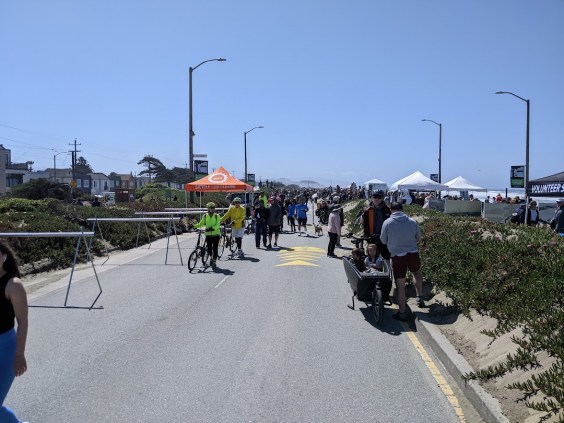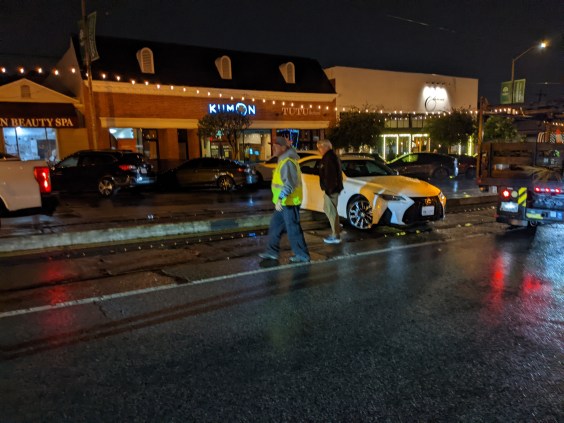Finally, state law will require Caltrans to plan and build a transportation system for everyone who uses California roads.
Complete and Safer Streets
Yesterday, Governor Newsom signed Senator Scott Wiener's Complete Streets bill, S.B. 960. This is a huge victory for proponents of safe and equitable streets, and the result of many years of advocacy. It's the third such bill introduced by Senator Wiener, after pushback from Caltrans and Newsom's veto of a previous version a few years ago despite overwhelming legislative support.
S.B. 960 requires Caltrans to prioritize road improvements for pedestrians, bike riders, and public transit users whenever it performs maintenance or does road work. That can include sidewalks, bike lanes, bus-only lanes, comfortable and accessible public transportation stops, frequent and safe crosswalks, median islands, accessible pedestrian signals, curb extensions, narrower travel lanes, and more. The bill also requires a faster and more transparent decision process for interactions with local jurisdictions who want to make safety changes on state highways that run through their communities.
This bill is not about freeways; many of the state highways Caltrans manages are streets that serve housing and commercial corridors and run through cities. "Caltrans won't let us" has frequently been the too-quick response from cities when residents have asked for safer crossings, bike lanes, and safer access to transit along many of these routes.
But many state-owned roads currently have no or deficient sidewalks, minimal crosswalks, no bike lanes, or any safe facilities for vulnerable road users, making them inaccessible or dangerous to many potential users. Nevertheless, when transportation and environmental advocacy groups dug into funding for Caltrans’s biggest road maintenance program, the State Highway Operation and Protection Program (SHOPP), they found that more than half of that program's projects had not a single complete streets element (and those that did were frequently minimal).
The bill's requirement for Caltrans to develop a public transit priority plan is a new area of focus for Caltrans' road planning, and it should make infrastructure like bus lanes and protected bus stops easier and faster to build. It requires Caltrans to track and report on investments in complete streets facilities, including transit priority facilities, and to set targets for complete streets in its state highway system management plan - and show progress towards those targets.
“Californians who get around by biking, walking, rolling, or taking transit have the same rights to safe passage on our streets as people driving cars," said Jared Sanchez, policy director for CalBike, one of the bill's sponsoring organizations. "True Complete Streets provide equitable use of our public space regardless of transit mode, economic status, or race. The Complete Streets Bill becoming law today moves us closer to the day when California state routes are among the safest streets in our communities, rather than the most deadly.”
More work is needed, as always. S.B. 960 still offers Caltrans ways to avoid doing the work that's needed. It will take local and state advocates - and the public - to hold the department accountable, and not accept weak rationales for disregarding the safety of pedestrians and bike riders.
Senator Wiener announced the signing at a press conference held at the corner of Lombard and Gough in San Francisco, where drivers killed two pedestrians in the last few months. Backed by the noisy flow of traffic and of buses pulling up, Wiener said he was happy and gratified that the bill was signed, and that it will help improve safety for people throughout the state.
"But there's another bill still on the Governor's desk," he said, referring to S.B. 961, which would require new cars to install existing technology that warns drivers when they exceed the speed limit. He cited statistics that show 4,000 people die on California roads every year, with another untold number of injuries, and pointed out that it's getting worse.
"We become numb" to these daunting numbers, he said. "But we have to remember that it's a policy choice to prioritize fast driving" - and that we can make different choices.
Making Transportation Funding Decisions More Transparent
This wasn't the only victory for safe streets this week. Newsom also signed a bill that calls on Caltrans to be more transparent about the California Transportation Plan, and specifically to do a financial analysis of it. Right now, this plan, which lays the groundwork for the state's future transportation system, is an "aspirational" plan without any solid discussion of funding sources - nor of where current funding is being spent or could be better spent.
A.B. 2086, from Assemblymember Pilar Schiavo, requires the plan to estimate the full cost of its implementation and to analyze what is feasible under realistic financial projections. It also requires Caltrans to make clear on its existing public online "dashboard" how annual investments are advancing the vision and goals of the California Transportation Plan.
The bill's sponsors, Transform and the Greenlining Institute, say it will bring much-needed transparency to Caltrans spending.
“The Transportation Accountability Act is critical to ensuring that California’s transportation dollars are spent on projects that enhance mobility options while mitigating the climate crisis, especially for our most transportation-burdened communities. Decision makers can’t shift investment priorities without data on how those investments are benefiting or harming communities today,” said Jeanie Ward-Waller, legislative advocate for Transform and director of transportation advocacy at Fearless Advocacy.
The California Air Resources Board estimates that half of California’s greenhouse gas emissions come from the transportation sector, and that Californians must reduce driving by 25 percent by 2030 to be on track to meet state climate goals. California has already created a framework for reducing emissions from transportation in its Climate Action Plan for Transportation Infrastructure (CAPTI).
But the extreme complexity of the state transportation budget makes it difficult to trace how priorities influence spending, and whether CAPTI is being taken seriously.
This current situation also makes it easier for Caltrans to make decisions with little public oversight, including continuing to build and expand highway projects that do not align with state climate and housing goals. California tends to promise big on climate, then turn around and spend money in ways that undermine those promises. Transform pointed out in a recent op-ed that that the projects California is funding with federal money from the Infrastructure Investments and Jobs Act (IIJA) will have a net negative effect on climate change.
Speed Cameras, but not Speed Enhancements, in Malibu
The release from the Governor's office buried the news of signing these bills under the fact that he also signed S.B. 1297 from Senator Ben Allen. That bill will add the city of Malibu to the speed camera pilot program. With any luck, Malibu is ready to get moving on it. None of the other cities in the pilot program, enabled by last year's A.B. 645 from Assemblymember Laura Friedman, have installed the cameras yet.
But Newsom also vetoed S.B. 1509, the “the "Negligent Operator Treatment (NOT) in California Act,” from Senator Henry Stern, which would have added points to a driver's record if they were cited for going more than 26 miles per hour over the speed limit. That veto disappointed the mayor of Malibu, who has said that simply increasing enforcement and ticketing hasn't been enough to slow drivers on a dangerous stretch of Pacific Coast Highway.






